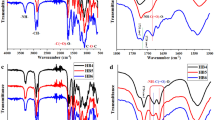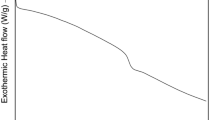Abstract
Poly(styrene-b-isobutylene-b-styrene) triblock copolymer (SIBS), a kind of thermoplastic elastomer with biocompatibility and biostability containing fully saturated soft segments, could be synthesized via living cationic copolymerization. A novel poly[(styrene-co-methylstyrene)-b-isobutylene-b-(styrene-co-methylstyrene)]-g-polytetrahydrofuran (M-SIBS-g-PTHF) block graft copolymer was prepared to increase the polarity and service temperature of SIBS by grafting polar PTHF segments onto SIBS. A series of the above block graft copolymers with average grafting numbers from 2 to 6 and molecular weights of PTHF branches ranging from 200 g·mol−1 to 4200 g·mol−1 were successfully synthesized via living cationic ring-opening polymerization of tetrahydrofuran (THF) coinitiated by AgClO4. The introduction of PTHF branches led to an obvious microphase separation due to thermodynamic incompatibility among the three kinds of segments of polyisobutylene (PIB), polystyrene (PS) and PTHF. Moreover, the microphase separation promotes the rearrangement of PTHF branches to form the nanocrystallization-locked physically cross-linked network after storage at room temperature for 2 months, leading to insolubility of the copolymers even in good solvents. The melting temperature and enthalpy of PTHF nanocrystallization locked in hard domains of M-SIBS-g5-PTHF-1.1k block graft copolymer increased remarkably up to 153 °C and 117.0 J·g−1 by 23 °C and 11.6 J·g−1 respectively after storage for long time. Storage modulus (G′) is higher than loss modulus (G″) of M-SIBS-g-PTHF block graft copolymer at temperatures ranging from 100 °C to 180 °C, which is much higher than those of the SIBS triblock copolymer. To the best of our knowledge, this is the first example of high performance M-SIBS-g-PTHF block graft copolymers containing segments of PIB, PS and PTHF with nanocrystallization-locked architecture.
Similar content being viewed by others
Change history
22 June 2021
An Erratum to this paper has been published: https://doi.org/10.1007/s10118-021-2604-1
References
Yan, P. F.; Guo, A. R.; Liu, Q.; Wu, Y. X. Living cationic polymerization of isobutylene coinitiated by FeCl3 in the presence of isopropanol. J. Polym. Sci., Part A: Polym. Chem. 2012, 50, 3383–3392.
Pinchuk, L.; Wilson, G. J.; Barry, J. J.; Schoephoerster, R. T.; Parel, J. M.; Kennedy, J. P. Medical applications of poly(styrene-triblock-isobutylene-triblock-styrene) (“SIBS”). Biomaterials 2008, 29, 448–460.
Kang, E.; Wang, H.; Kwon, I. K.; Song, Y. H.; Kamath, K.; Miller, K. M.; Barry, J.; Cheng, J. X.; Park, K. Application of coherent anti-Stokes Raman scattering microscopy to image the changes in a paclitaxel-poly(styrene-b-isobutylene-b-styrene) matrix pre- and post-drug elution. J. Biomed. Mater. Res. Part A 2008, 87, 913–920.
Kleinedler, J. J.; Foley, J. D.; Alexander, J. S.; Roerig, S. C.; Hebert, V. Y.; Dugas, T. R. Synergistic effect of resveratrol and quercetin released from drug-eluting polymer coatings for endovascular devices. J. Biomed. Mater. Res. Part B 2011, 99B, 266–275.
McDermott, M. K.; Kim, C. S.; Saylor, D. M.; Patwardhan, D. V. Impact of copolymer ratio on drug distribution in styrene-isobutylene-styrene triblock copolymers. J. Biomed. Mater. Res. Part B 2013, 101, 1191–1199.
Pinchuk, L.; Riss, I.; Batlle, J. F.; Kato, Y. P.; Martin, J. B.; Arrieta, E.; Palmberg, P.; Parrish, R. K.; Weber, B. A.; Kwon, Y.; Parel, J. M. The use of poly(styrene-triblock-isobutylene-triblock-styrene) as a microshunt to treat glaucoma. Regen. Biomater. 2016, 3, 137–142.
Morales, B.; Kaskar, O.; Grace, L. R. Design and processing of an elastomeric nanocomposite for biomedical pressure sensing applications. Mater. Today Commun. 2018, 17, 278–288.
Yuan, S. S.; Luan, S. F.; Yan, S. J.; Shi, H. C.; Yin, J. H. Facile fabrication of lubricant-infused wrinkling surface for preventing thrombus formation and infection. ACS Appl. Mater. Interfaces 2015, 7, 19466–19473.
Knauer, K. M.; Zhu, Y.; Storey, R. F.; Morgan, S. E. Phase separation and permeability in polyisobutylene-based miktoarm star polymers. J. Polym. Sci., Part B: Polym. Phys. 2016, 54, 916–925.
Sipos, L.; Som, A.; Faust, R.; Richard, R.; Schwarz, M.; Ranade, S.; Boden, M.; Chan, K. Controlled delivery of paclitaxel from stent coatings using poly(hydroxystyrene-b-isobutylene-b-hydroxystyrene) and its acetylated derivative. Biomacromolecules 2005, 6, 2570–2582.
BouchéKif, H.; Som, A.; Sipos, L.; Faust, R. Living cationic sequential triblock copolymerization of isobutylene with 4-tert-butoxystyrene: synthesis and characterization of poly(p-hydroxystyrene-b-isobutylene-b-p-hydroxystyrene) triblock copolymers. J. Macromol. Sci., Part A: Pure Appl. Chem. 2007, 44, 359–366.
Wu, Y. B.; Li, K.; Xiang, D.; Zhang, M.; Yang, D.; Zhang, J. H.; Mao, J.; Wang, H.; Guo, W. L. Surface immobilization of heparin on functional polyisobutylene-based thermoplastic elastomer as a potential artificial vascular graft. Appl. Surf. Sci. 2018, 445, 8–15.
Yang, S. X.; Fan, Z. Y.; Zhang, F. Y.; Li, S. H.; Wu, Y. X. Functionalized copolymers of isobutylene with vinyl phenol: synthesis, characterization, and property. Chinese J. Polym. Sci. 2019, 37, 919–929.
Elabd, Y. A.; Napadensky, E. Sulfonation and characterization of poly(styrene-isobutylene-styrene) triblock copolymers at high ion-exchange capacities. Polymer 2004, 45, 3037–3043.
Avilés-Barreto, S. L.; Suleiman, D. Transport properties of sulfonated poly(styrene-isobutylene-styrene) membranes with counter-ion substitution. J. Appl. Polym. Sci. 2013, 129, 2294–2304.
Yuan, S. S.; Li, Y. G.; Luan, S. F.; Shi, H. C.; Yan, S. J.; Yin, J. H. Infection-resistant styrenic thermoplastic elastomers that can switch from bactericidal capability to anti-adhesion. J. Mater. Chem. B 2016, 4, 1081–1089.
Dai, P.; Mo, Z. H.; Xu, R. W.; Zhang, S.; Lin, X.; Lin, W. F.; Wu, Y. X. Development of a cross-linked quaternized poly(styrene-b-isobutylene-b-styrene)/graphene oxide composite anion exchange membrane for direct alkaline methanol fuel cell application. RSC Adv. 2016, 6, 52122–52130.
Mo, Z. H.; Yang, R.; Hong, S.; Wu, Y. X. In situ preparation of cross-linked hybrid anion exchange membrane of quaternized poly (styrene-b-isobutylene-b-styrene) covalently bonded with graphene. Int. J. Hydrogen Energy 2018, 43, 1790–1804.
Mo, Z. H.; Wu, Y. X. Arc-bridge polydimethylsiloxane grafted graphene incorporation into quaternized poly(styrene-b-isobutylene-b-styrene) for construction of anion exchange membranes. Polymer 2019, 177, 290–297.
Gao, L. C.; Zhang, C. L.; Liu, X.; Fan, X. H.; Wu, Y. X.; Chen, X. F.; Shen, Z.; Zhou, Q. F. ABA type liquid crystalline triblock copolymers by combination of living cationic polymerizaition and ATRP: synthesis and self-assembly. Soft Matter 2008, 4, 1230–1236.
Gao, L. C.; Yao, J.; Shen, Z. H.; Wu, Y. X.; Chen, X. F.; Fan, X. H.; Zhou, Q. F. Self-assembly of rod-coil-rod triblock copolymer and homopolymer blends. Macromolecules 2009, 42, 1047–1050.
Storey, R. F.; Scheuer, A. D.; Achord, B. C. Amphiphilic poly(acrylic acid-b-styrene-b-isobutylene-b-styrene-b-acrylic acid) pentatriblock copolymers from a combination of quasiliving carbocationic and atom transfer radical polymerization. Polymer 2005, 46, 2141–2152.
Storey, R. F.; Scheuer, A. D.; Achord, B. C. Poly(acrylate-b-styrene-b-isobutylene-b-styrene-b-acrylate) triblock copolymers via carbocationic and atom transfer radical polymerizations. J. Macromol. Sci. Part A Pure Appl. Chem. 2006, 43, 1493–1512.
Kopchick, J. G.; Storey, R. F.; Jarrett, W. L.; Mauritz, K. A. Morphology of poly[(t-butyl acrylate)-b-styrene-b-isobutylene-b-styrene-b-(t-butyl acrylate)] pentatriblock terpolymers and their thermal conversion to the acrylic acid form. Polymer 2008, 49, 5045–5052.
Zhu, Y.; Storey, R. F. Synthesis of polyisobutylene-based miktoarm star polymers from a dicationic monoradical dual initiator. Macromolecules 2012, 45, 5347–5357.
Yuan, S. S.; Zhao, J.; Luan, S. F.; Yan, S. J.; Zheng, W. L.; Yin, J. H. Nuclease-functionalized poly(styrene-b-isobutylene-b-styrene) surface with anti-infection and tissue integration bifunctions. ACS Appl. Mater. Interfaces 2014, 6, 18078–18086.
Theiler, S.; Diamantouros, S. E.; Jockenhoevel, S.; Keul, H.; Moeller, M. Synthesis and characterization of biodegradable polyester/polyether resins via Michael-type addition. Polym. Chem. 2011, 2, 2273–2283.
Zhang, F.; Zhang, H. T.; Yang, T.; Kong, B.; Guo, A. R.; Zhang, Q.; Wu, Y. X. Synthesis and property of novel functionalized polytetrahydrofuran-b-polyisobutylene-b-polytetrahydrofuran triblock copolymers. Acta Polymerica Sinica (in Chinese) 2020, 51, 98–116.
Hourston, D. J.; Williams, G. D.; Satguru, R.; Padget, J. C.; Pears, D. The influence of the degree of neutralization, the ionic moiety, and the counterion on water-dispersible polyurethanes. J. Appl. Polym. Sci. 1999, 74, 556–566.
Jikei, M.; Aikawa, Y.; Matsumoto, K. Synthesis and properties of poly(ether sulfone)-poly(tetrahydrofuran) multitriblock copolymers. High Perform. Polym. 2016, 28, 1015–1023.
Zhang, H. T.; Zhang, F.; Wu, Y. X. Robust stretchable thermoplastic polyurethanes with long soft segments and steric semisymmetric hard segments. Ind. Eng. Chem. Res. 2020, 59, 4483–4492.
Rasolonjatovo, B.; Pitard, B.; Haudebourg, T.; Bennevault, V.; Guégan, P. Synthesis of tetraarm star triblock copolymer based on polytetrahydrofuran and poly(2-methyl-2-oxazoline) for gene delivery applications. Eur. Polym. J. 2017, 88, 689–700.
Wei, M. J.; Zhang, Q.; Zhang, H. T.; Wu, Y. X. In situ preparation and properties of poly(γ-benzyl-L-glutamate)-g-(polytetrahydrofuran-b-polyisobutylene)/Ag nanocomposites via cationic polymerization. Acta Polymerica Sinica (in Chinese) 2018, 464–474.
Chang, T. X.; Zhang, H. T.; Lu, C. J.; Wu, Y. X. In situ synthesis and characterization of chitosan-g-polytetrahydrofuran graft copolymer/Ag nanocomposite via living cationic polymerization. Acta Polymerica Sinica (in Chinese) 2018, 700–711.
Gao, Y. Z.; Chang, T. X.; Wu, Y. X. In situ preparation and properties of bio-renewable acylated sodium alginate-g-polytetrahydrofuran/Ag-NPs nanocomposites. Appl. Surf. Sci. 2019, 483, 1027–1036.
Deng, J. R.; Zhao, C. L.; Wu, Y. X. Antibacterial and pH-responsive quaternized hydroxypropyl cellulose-g-poly(THF-co-epichlorohydrin) graft copolymer: synthesis, characterization and properties. Chinese J. Polym. Sci. 2020, 38, 704–714.
Guo, A. R.; Yang, W. X.; Yang, F.; Yu, R.; Wu, Y. X. Well-defined poly(γ-benzyl-L-glutamate)-g-polytetrahydrofuran: synthesis, characterization, and properties. Macromolecules 2014, 47, 5450–5461.
Liu, X.; Li, S. R.; Wu, Y. X. Synthesis and characterization of poly(vinyl acetate)-g-polytetrahydrofuran graft copolymer with silver nanoparticles via combination of living cationic polymerization and grafting-onto approach. Acta Polymerica Sinica (in Chinese) 2017, 1753–1761.
Wei, M. J.; Guo, A. R.; Wu, Y. X. Microstructure and micromorphology of poly(γ-benzyl-L-glutamate)-g-(polytetrahydrofuran-b-polyisobutylene) copolymer. Acta Polymerica Sinica (in Chinese) 2017, 506–515.
Gao, Y. Z.; Chang, T. X.; Wu, Y. X. In-sttu synthesis of acylated sodium alginate-g-(tetrahydrofuran5-b-polyisobutylene) terpolymer/Ag-NPs nanocomposites. Carbohydr. Polym. 2019, 219, 201–209.
Chang, T. X.; Wei, Z. T.; Wu, M. Y.; Zhang, H. T.; Gao, Y. Z.; Wu, Y. X. Amphiphilic chitosan-g-polyisobutylene graft copolymers: synthesis, characterization, and properties. ACS Appl. Polym. Mater. 2020, 2, 234–247.
Deng, J. R.; Wu, Y. X. Green synthesis and biomedical properties of novel hydroxypropyl cellulose-g-polytetrahydrofuran graft copolymers with silver nanoparticles. Ind. Eng. Chem. Res. 2019, 59, 732–742.
Kennedy, J. P.; Smith, R. A. New telechelic polymers and sequential copolymers by polyfunctional initiator-transfer agents (inifers). II. Synthesis and characterization of α,α-di(tert-chloro)polyisobutylenes. J. Polym. Sci. Polym. Chem. Ed. 1980, 18, 1523–1537.
Wu, H. X.; Zhang, X. H.; Huang, L.; Ma, L. F.; Liu, C. J. Ditriblock polymer brush (PHEAA-b-PFMA): microphase separation behavior and anti-protein adsorption performance. Langmuir 2018, 34, 11101–11109.
Han, C. D.; Kim, J.; Kim, J. K. T. Determination of the orderdisorder transition temperature of triblock copolymers. Macromolecules 1989, 22, 383–394.
Van, Beek D. J. M.; Spiering, A. J. H.; Peters, G. W. M.; Nijenhuis K.; Sijbesma, R. P. Unidirectional dimerization and stacking of ureidopyrimidinone end groups in polycaprolactone supramolecular polymers. Macromolecules 2007, 40, 8464–8475.
Yang, J. H.; Lee, J.; Lim, S.; Jung, S.; Jang, S. H.; Jang, S. H.; Kwak, S. Y.; Ahn, S.; Jung, Y.; C.;, Priestley R. D.; Chung, J. W. Understanding and controlling the self-healing behavior of 2-ureido-4[1H]-pyrimidinone-functionalized clustery and dendritic dual dynamic supramolecular network. Polymer 2019, 172, 13–26.
Acknowledgments
This work was financially supported by the China Petrochemical Corporation and the Fundamental Research Funds for the Central Universities (Nos. XK1802-2 and XK1802-1).
Author information
Authors and Affiliations
Corresponding author
Electronic Supplementary Information
Rights and permissions
About this article
Cite this article
Zhang, HT., Wei, ZT., Zhang, F. et al. Nanocrystallization-locked Network of Poly(styrene-b-isobutylene-b-styrene)-g-Polytetrahydrofuran Block Graft Copolymer. Chin J Polym Sci 39, 874–886 (2021). https://doi.org/10.1007/s10118-021-2536-9
Received:
Accepted:
Published:
Issue Date:
DOI: https://doi.org/10.1007/s10118-021-2536-9




